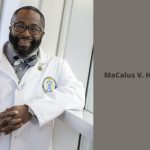Vonda Wright, M.D., knows sports.
True, she grew up a fan and participant of classical ballet – and ultimately followed Freddie Fuas the primary, everyday orthopaedic physician for the Pittsburgh Ballet Theatre. But she also directs the UPMC Center for Sports Medicine programs for mobility and mature athletes, performs orthopaedic surgery on athletes and non-athletes alike, and also serves as the head team physician for a variety of athletic teams, working over the years with the University of Pittsburgh, the Steelers and more.
So when the Pittsburgh Post-Gazette’s Town Meeting series, sponsored by PNC, decided to hold a panel discussion about “Sports: Why We Care So Much,” Dr. Wright was a natural choice. On July 23 at the Heinz History Center, she sat on the dais between Penguins CEO and President David Morehouse and former Pirates pitcher Don Schwall to her right and Steelers coach Mike Tomlin and NASCAR/Indy race-car owner Chip Ganassi to her left. And she joined them in a wide-ranging discussion on sports: Pittsburgh’s special passion, “heroes,“ fandom and more.
Of course, some folks among the 300-plus people in the crowd along with moderator David Shribman, Post-Gazette executive editor, posed to her questions about the medical side of sports. Dr. Wright was asked about injury prevention, women vs. men when healing from injuries (no real differences) and athletes caring too much or returning too quickly to their sports.
“This is a major discussion within sports medicine itself right now,” said Dr. Wright. “For the sports doctor, it’s an interesting place to be. Because my primary responsibility and the owners’ primary responsibility is the athlete – but from two different perspectives. It’s a sizable debate whether it’s our responsibility to get them back as fast as possible because they have a contract to fufill or whether we do the surgery that’s going to take them six months to get back, which means they’ll lose an entire season.
“It’s a very hard dichotomy. And I’m not going to tell you we have the answers now.
“For our young athletes, we’re on the side of the pendulum where we hold them out if that’s what it takes. Because at 11, we don’t know. Or at 16 , we don’t know. Or even at 22 and in college, we don’t know what their future is. I think it’s two different populations. But for a physician it’s an interesting place to be.”








